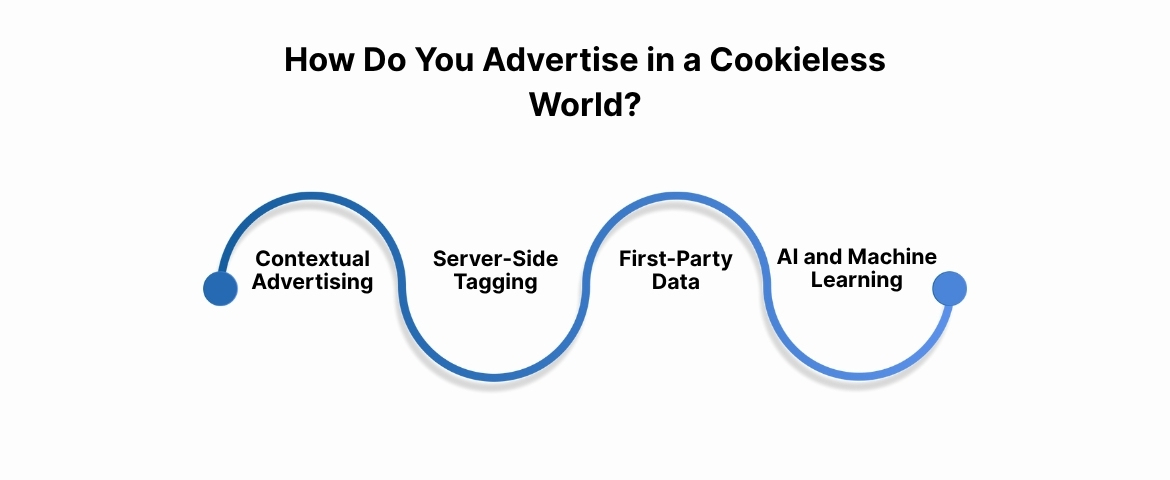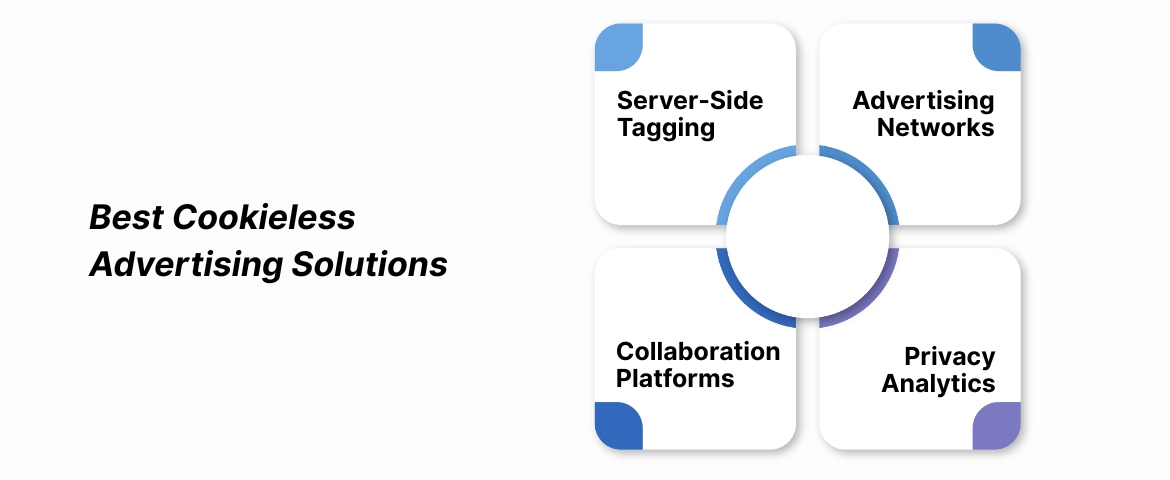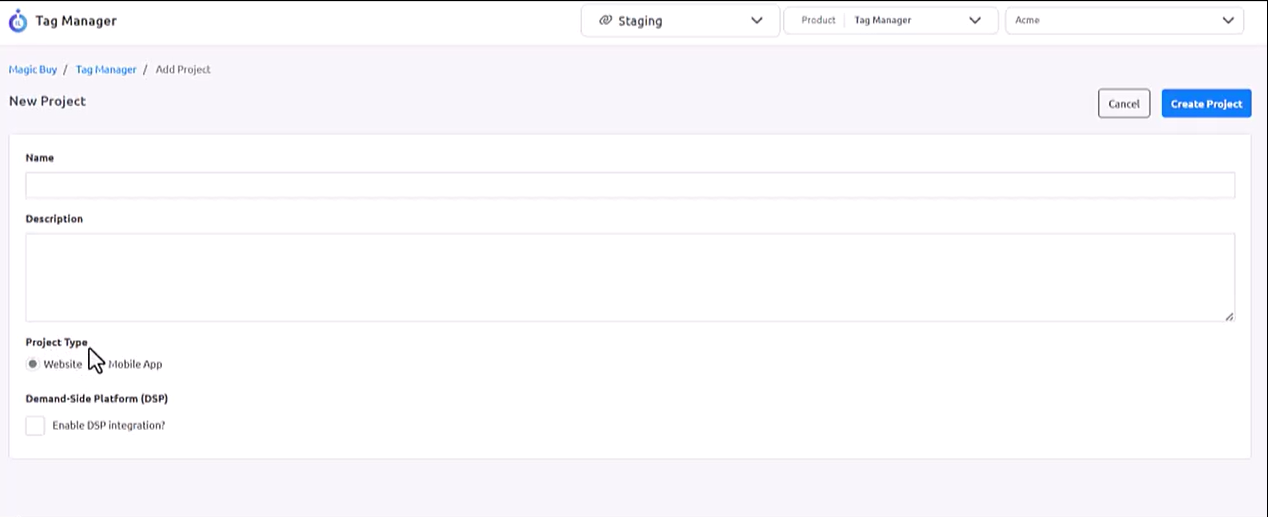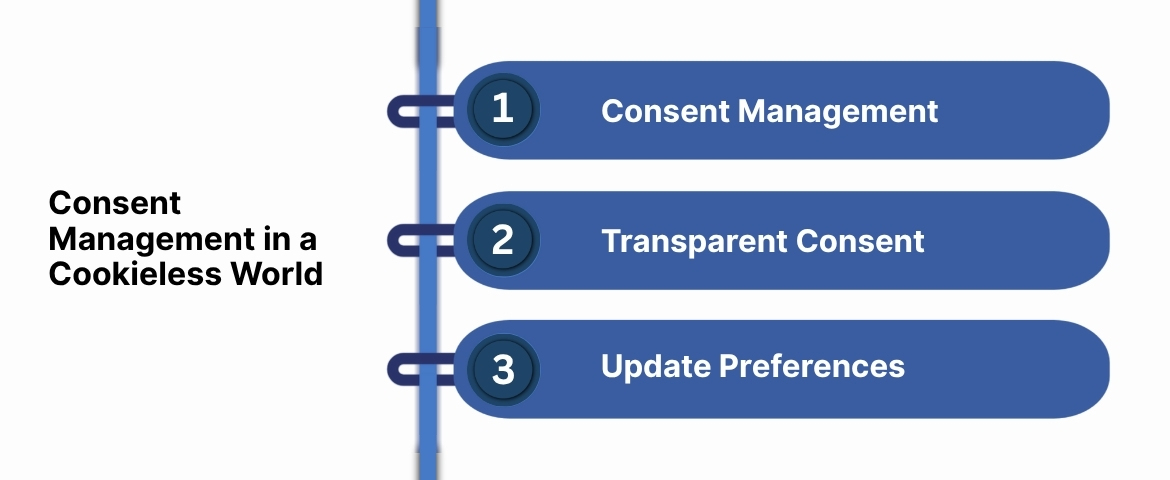Thriving with Cookieless Advertising Solutions for the Future
Are you ready for the shift in digital advertising?
The decline of third-party cookies is reshaping how businesses connect with consumers. In the U.S., the retail media market, which utilizes first-party data for targeted advertising, is projected to reach $82 billion by 2027, growing at a 17% annual rate. This growth highlights the increasing importance of privacy-compliant advertising strategies.
Consumer preferences are also evolving. Consumer preferences are evolving, with fewer perceived privacy violations in advertising. This means they generally perceive advertising practices as less invasive. This approach keeps data on their devices, such as contextual targeting, compared to those that involve tracking across multiple sites.
TL;DR
- Privacy & Compliance: With rising privacy laws (GDPR, CCPA), businesses must shift from third-party cookies to ensure compliance and trust.
- Privacy-First Solutions: Focus on first-party data, contextual ads, and server-side tagging to personalize marketing without infringing privacy.
- Effective Strategies: Utilize AI, consent-based data collection, and contextual advertising to engage users without tracking.
- Future-Ready: Cookieless advertising enhances customer trust, keeps you compliant, and ensures your marketing remains effective long-term.
What is Cookieless Advertising?
Cookieless advertising refers to marketing strategies that don’t rely on third-party cookies to track users across websites. With privacy concerns on the rise, businesses need to adopt more secure methods of targeting customers. This new approach focuses on protecting user privacy while still enabling personalized experiences.
By using cookieless advertising solutions, you can continue to engage with users in ways that align with global privacy standards. These methods prioritize first-party data, contextual targeting, and privacy-first technologies. This approach simplifies compliance with regulations like GDPR and CCPA. Recent updates, such as Google's decision to retain third-party cookie choice in Chrome in 2024, underscore the industry's ongoing shift toward privacy-centric advertising practices. Cookieless advertising helps you build trust with consumers while delivering relevant ads without violating their privacy.
As the industry moves toward more transparent practices, implementing cookieless advertising becomes essential for staying ahead. This shift enhances customer relationships without compromising privacy and trust.
Up next, let’s take a look at what cookies really are and how they’ve shaped advertising practices.
What Are Cookies?
Cookies are small data pieces stored on a user’s device to track online behavior. They remember preferences, login details, and track movements across sites. In advertising, cookies build profiles and deliver personalized ads.
Websites set first-party cookies, while third-party cookies track users across multiple sites for advertising. Cookies provide valuable insights for advertisers, but they also raise privacy concerns. As privacy awareness grows, stricter regulations have been imposed on cookies. This shift has pushed businesses to look for cookieless advertising solutions.
As cookies face increasing scrutiny, the next question becomes: Why are third-party cookies being phased out, and what does that mean for advertisers?
Also read: Understanding Cookie Size Limits in Modern Browsers
Why Are Third-Party Cookies Being Phased Out?
Third-party cookies are being phased out due to rising privacy concerns and regulations. Consumers want greater control over their data. Governments' laws, such as GDPR and CCPA, limit cookie usage for tracking purposes.
Browsers like Chrome, Safari, and Firefox have started blocking third-party cookies. Browsers blocking third-party cookies push businesses toward cookieless advertising solutions. These solutions provide targeted campaigns that respect user privacy. By implementing cookieless solutions, businesses can foster consumer trust and comply with evolving privacy regulations. This opportunity allows you to lead in privacy-first marketing.
But how do you successfully advertise in this new environment? Let’s walk through some strategies for marketing without cookies.
How Do You Advertise in a Cookieless World?

Advertising in a cookieless world may seem daunting, but with the right strategies, you can continue to reach your target audience effectively. As digital marketers, it's crucial to evolve and adopt alternatives that prioritize privacy without compromising the relevance of your content.
Here are some of the most effective approaches to advertising in this new landscape:
- Contextual AdvertisingContextual advertising offers a strong alternative to cookies by targeting ads based on the content surrounding the user, rather than their personal data. For instance, if a user is reading a blog about fitness, ads for gym equipment or supplements can be shown. This method allows you to maintain relevance and personalization while complying with privacy standards. By focusing on the context of the content a user interacts with, you can still deliver meaningful and timely ads that resonate with your audience, without relying on cookies or user tracking.Ingest Labs’ Event IQ platform offers real-time tracking and insights, helping you measure the impact of contextual advertising across various platforms.
- Server-Side TaggingServer-side tagging allows you to collect and process user data on the server, rather than on the client’s browser. This shift reduces reliance on third-party cookies and increases data security. By handling data on your servers, you not only improve performance but also ensure compliance with privacy laws. This solution supports cookieless advertising by maintaining tracking and campaign optimization without invasive cookies, giving you more control over user data.With Ingest IQ, you can implement robust server-side tracking to bypass browser limitations, ensuring accurate data collection while maintaining privacy compliance.
- First-Party DataFirst-party data is one of the most valuable assets in a cookieless world. By collecting data directly from your users through interactions on your website or app, you can create personalized experiences while ensuring privacy. Encourage users to opt in by offering incentives like personalized offers or exclusive content in exchange for sharing their preferences or purchase history. This helps you build stronger relationships with customers, ensuring that your marketing efforts remain effective even without cookies.
- AI and Machine LearningAI and machine learning play a crucial role in cookieless advertising by helping you predict and understand user behavior without relying on third-party cookies. These technologies analyze large sets of data to uncover patterns and trends, enabling you to personalize your campaigns in real-time. With machine learning models, you can target the right customers at the right time, optimizing your campaigns and improving ROI. This approach allows you to adapt and stay relevant in a cookieless world while respecting privacy regulations.
Next, we'll explore some of the best solutions available today to assist you in managing this cookieless landscape.
Best Cookieless Advertising Solutions

As the digital marketing landscape moves toward cookieless advertising, you may wonder how to maintain effective targeting and personalization without infringing on privacy. Fortunately, several innovative solutions are designed to help you achieve just that. Here are some of the most effective options to consider:
1. Server-Side Tagging Solutions
One of the most reliable methods in a cookieless world is server-side tagging, instead of relying on cookies placed on users' devices, this process data directly on your server. This not only improves website performance but also enhances privacy by minimizing reliance on third-party cookies.
Examples of popular server-side tagging solutions include Ingest Labs, Segment, and Google Tag Manager (server-side setup). These platforms give you greater control over the data you collect while ensuring compliance with privacy regulations.
To integrate Ingest Labs server-side tagging into your workflow, use Ingest IQ. Then, add your project’s server container by navigating to the “Tag Manager” section, selecting “Add a New Container,” choosing “Server” as the type, and following the guided setup.
Watch this for a detailed step-by-step approach.

2. Contextual Advertising Networks
Another effective approach to cookieless advertising is contextual advertising. This strategy focuses on delivering ads based on the content the user is currently engaging with, rather than relying on their browsing history. For example, a user reading an article about fitness might see ads for gym equipment or health supplements.
3. Data Collaboration Platforms
When you need more data insights but want to respect privacy, data collaboration platforms can be an excellent solution. These platforms enable brands to securely share aggregated data, allowing for better targeting and campaign optimization while maintaining privacy compliance.
4. Privacy-First Analytics Tools
Privacy-first analytics tools focus on collecting first-party data directly from your users. These tools are designed to comply with privacy laws while still providing meaningful insights into user behavior and campaign performance.
These cookieless advertising solutions, server-side tagging, contextual networks, data collaboration platforms, and privacy-first analytics enable you to continue running effective marketing campaigns without compromising privacy. Now, let's explore methods for gathering data while protecting privacy effectively.
Strategies for Data Collection in a Cookieless World
As third-party cookies phase out, finding new ways to collect data is crucial. Fortunately, there are several strategies to gather the data you need while still prioritizing user privacy. These methods focus on using first-party data and consent-based collection to ensure compliance with privacy laws.
1. Emphasize First-Party Data Collection
The most reliable form of data in a cookieless world is first-party data. This refers to the data you collect directly from your customers or users through interactions with your website, app, or emails. By collecting first-party data, you not only ensure privacy compliance but also gain richer, more accurate insights into your audience.
- Encourage users to sign up for newsletters or loyalty programs.
- Offer personalized recommendations in exchange for sharing preferences or purchase history.
Example: A retail website can prompt users to sign up for a rewards program in exchange for personalized offers. This allows the brand to collect valuable first-party data while providing an incentive for customers to engage.
2. Utilize Consent-Based Data Collection
In a cookieless environment, getting explicit consent from your users is essential for any data collection. Implementing clear, easy-to-understand consent management systems ensures that your users know what data you're collecting and how it will be used.
- Use pop-ups or banners that allow users to choose whether they want to accept cookies, participate in data collection, or both.
- Provide users with options to opt out or manage their preferences at any time.
Example: A website can display a consent banner asking users if they agree to share data for personalized ads, ensuring transparency and control over their data.
Ingest Labs Tag Manager allows you to configure tags, triggers, and data elements so that tracking and data collection only occur after consent is granted. You can set up qualification criteria and triggers to ensure tags fire only when the user has opted in, and halt tracking immediately if consent is withdrawn.
3. Data Enrichment for Enhanced Targeting
While first-party data is invaluable, you can also enhance it with data enrichment techniques. This involves supplementing your existing customer data with additional, publicly available data sources. These can include demographic information, company data, or other non-sensitive datasets that help improve your audience profiles.
- Partner with third-party providers to access enriched datasets in a privacy-compliant manner.
- Ensure any additional data you acquire is aggregated and anonymized to protect user identity.
Next, we’ll concentrate on how to manage consent in a cookieless world, ensuring compliance with privacy laws while building trust with your users.
Consent Management in a Cookieless World

With growing privacy concerns and regulations, consent management has become an essential part of digital marketing strategies. It allows businesses to collect data ethically and in compliance with global privacy laws.
1. Implement Advanced Consent Management Platforms
A Consent Management Platform (CMP) helps businesses manage user consent for cookies and data collection. These platforms enable you to gather and store consent records, ensuring compliance with privacy regulations.
- Use CMPs to ask for consent before collecting data or activating cookies.
- Ensure the platform offers detailed reports and logs for auditing purposes.
Ingest Labs offers automated consent tracking that simplifies operations, reduces manual work, and ensures detailed audit records for compliance and DSARs. It also integrates with over 100 connectors to synchronize consent data across your tech stack.
2. Provide Clear and Transparent Consent Options
Transparency is key when asking users for consent. Your consent requests should be clear and informative, allowing users to make an informed decision about what data they are willing to share.
- Allow users to choose granular data sharing options (e.g., opting into personalized ads or analytics).
- Display a clear privacy policy that explains how user data will be used and protected.
Example: A website might offer a clear "Cookie Preferences" page where users can select whether they want personalized ads or simply consent to general tracking for analytics purposes.
Ingest ID helps provide clarity by assigning a unique identifier to each visitor, enabling a transparent and compliant approach to consent management and tracking across digital touchpoints.
3. Keep User Preferences Updated
Once users grant consent, it’s crucial to update and manage preferences regularly. Keeping your consent records up to date allows you to maintain ongoing compliance with data protection regulations.
- Offer users the ability to modify or withdraw their consent at any time.
- Send periodic reminders to users about their data preferences and how to adjust them.
Example: Offering users an easy-to-access "Manage Preferences" section on your site lets them update their consent choices as needed. Ingest IQ enables seamless consent tracking and allows you to synchronize user preferences across platforms, ensuring your data remains compliant and up-to-date.
As we conclude our discussion on consent management, it is now pertinent to address the rise of contextual advertising and its increasing significance in cookieless marketing.
The Rise of Contextual Advertising
As privacy laws tighten and cookies become obsolete, contextual advertising has emerged as a powerful solution. This approach focuses on delivering relevant ads based on the content a user is currently viewing, rather than their personal browsing history.
1. How Contextual Advertising Works?
Contextual advertising works by matching ads to the surrounding content a user is engaging with. For example, if a user is reading a blog post about traveling, they might see ads for travel insurance or vacation packages. This method ensures that ads are relevant to the current context and interests of the user without needing to track their behavior across websites.
- It relies on keywords, topics, and page content to deliver ads that align with the user's current activity.
- Ads are served based on the page’s content, not user behavior, ensuring privacy and compliance.
Example: If you're running a fitness-related ad campaign, your ad will appear on relevant content such as workout guides or health blogs, which makes it contextually relevant without requiring any data tracking.
2. Benefits of Contextual Advertising
There are several key benefits to using contextual advertising in a cookieless world:
- Privacy-Friendly: It respects user privacy by avoiding personal tracking and focusing on content-based relevance.
- Increased Engagement: Ads are shown to users based on their current interests, leading to higher engagement and conversion rates.
- Better Compliance: Contextual advertising aligns with privacy laws since it does not rely on personal data or tracking.
Ingest Labs enables privacy-first, server-side data collection and tag management, allowing advertisers to deploy and monitor contextual ad strategies that are fully compliant and do not rely on third-party cookies or personal identifiers. Its platform offers real-time tag management, 100+ integrations, and server-side tracking to ensure that contextual advertising campaigns are both effective and privacy-safe
Final Thoughts
Managing a cookieless world may seem challenging, but by leveraging innovative strategies and tools, you can continue to deliver effective advertising while respecting user privacy. From first-party data collection and consent management platforms to contextual advertising, the solutions are out there to help you succeed. As privacy laws evolve, embracing these cookieless solutions not only ensures compliance but also builds trust with your audience, ensuring long-term marketing success. To do so, start implementing a robust first-party data strategy and regularly audit your privacy compliance practices.
Ingest Labs offers a comprehensive suite of tools like Ingest IQ, Ingest ID, and Event IQ to help you navigate a cookieless world. With advanced consent management, first-party data collection, and server-side tracking, these solutions simplify compliance and enhance marketing effectiveness. Ingest Labs seamlessly integrates data across platforms. This ensures your campaigns are data-driven and privacy-compliant. The result is building lasting customer trust.
Ready to overcome advertising challenges with innovative cookieless solutions? Contact Ingest Labs today and discover how our expertise can help you achieve more effective and privacy-compliant campaigns!
FAQ
1. What is cookieless advertising?
It’s a strategy that doesn’t use third-party cookies, focusing on first-party data, contextual targeting, and server-side tagging to respect privacy.
2. Why is cookieless advertising important?
It ensures compliance with privacy laws like GDPR and CCPA while maintaining effective user engagement without compromising privacy.
3. How does cookieless advertising work?
It uses first-party data, content-based targeting, and server-side tracking instead of cookies to deliver personalized ads.
4. What are the benefits of cookieless advertising?
It enhances privacy, builds trust, improves data security, and allows accurate targeting without relying on cookies.
5. How can I transition to cookieless advertising?
Start by using first-party data, implementing consent management systems, and implementing contextual advertising and server-side tracking to ensure compliance and effectiveness.






